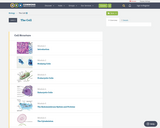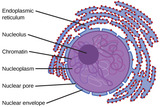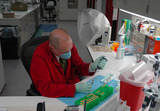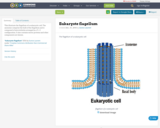
This is a Introduction to microbiology course. The content of this module is syllabus as well as powerpoint slides presentation, using OpenStax Microbiology textbook. Content uploaded by Joanna Gray. All content created by Jaleh E. Jalili

This is a Introduction to microbiology course. The content of this module is syllabus as well as powerpoint slides presentation, using OpenStax Microbiology textbook. Content uploaded by Joanna Gray. All content created by Jaleh E. Jalili

Biology is designed for multi-semester biology courses for science majors. It is grounded on an evolutionary basis and includes exciting features that highlight careers in the biological sciences and everyday applications of the concepts at hand. To meet the needs of today’s instructors and students, some content has been strategically condensed while maintaining the overall scope and coverage of traditional texts for this course. Instructors can customize the book, adapting it to the approach that works best in their classroom. Biology also includes an innovative art program that incorporates critical thinking and clicker questions to help students understand—and apply—key concepts.


By the end of this section, you will be able to:Describe the structure of eukaryotic cellsCompare animal cells with plant cellsState the role of the plasma membraneSummarize the functions of the major cell organelles




By the end of this section, you will be able to:Identify and describe the properties of lifeDescribe the levels of organization among living thingsRecognize and interpret a phylogenetic treeList examples of different sub disciplines in biology

By the end of this section, you will be able to:Identify and describe the properties of lifeDescribe the levels of organization among living thingsRecognize and interpret a phylogenetic treeList examples of different sub disciplines in biology

This resource is a video abstract of a research paper created by Research Square on behalf of its authors. It provides a synopsis that's easy to understand, and can be used to introduce the topics it covers to students, researchers, and the general public. The video's transcript is also provided in full, with a portion provided below for preview:
"Microbiomes are more than just prokaryotes and viruses; they also contain important eukaryotes, including fungi and protists. However, eukaryotes are difficult to study using ‘shotgun’ metagenomics, as their signal is often overwhelmed by the prokaryotes. Some methods use eukaryote-specific marker genes, but they can’t detect eukaryotes that aren’t in the reference marker gene set, and such methods are not compatible with web-based tools for downstream analysis. But CORRAL (Clustering Of Related Reference ALignments) is designed to close those gaps. CORRAL identifies eukaryotes in metagenomic data based on alignments to eukaryote-specific marker genes and Markov clustering. It can detect microbial eukaryotes that are not included in the marker gene reference set. The process is even automated and can be carried out at scale. A recent paper demonstrates CORRAL’s sensitivity and accuracy with simulated datasets, mock community standards, and human microbiome datasets..."
The rest of the transcript, along with a link to the research itself, is available on the resource itself.

In this lesson, the students look at the components of cells and their functions. The lesson focuses on the difference between prokaryotic and eukaryotic cells. Each part of the cell performs a specific function that is vital for the cell's survival. Bacteria are single-celled organisms that are very important to engineers. Engineers can use bacteria to break down toxic materials in a process called bioremediation, and they can also kill or disable harmful bacteria through disinfection.

In this unit, students look at the components of cells and their functions and discover the controversy behind stem cell research. The first lesson focuses on the difference between prokaryotic and eukaryotic cells. In the second lesson, students learn about the basics of cellular respiration. They also learn about the application of cellular respiration to engineering and bioremediation. The third lesson continues students' education on cells in the human body and how (and why) engineers are involved in the research of stem cell behavior.

This illustrate the flagellum of a eukaryotic cell. The axoneme comprise the bulk of the flagellum and is composed of microtubules arranged in a 9 + 2 configuration. It also contains motor proteins and other components not shown.

This chapter details cell-cell communication highlighting studies performed in the model organism Dictyostelium discoideum. Topics covered include signaling molecules, cell surface receptors, and subversion of host cell signaling by pathogens.

This micrograph was taken at 1000X total magnifcation on a brightfield microscope. The subject is human cheek epithelial cells collected fresh with a toothpick. The cells were stained with methylene blue stain prior to visualization.Image credit: Emily Fox

This micrograph was taken at 1000X total magnifcation on a brightfield microscope. The subject is human cheek epithelial cells collected fresh with a toothpick. The cells were stained with methylene blue stain prior to visualization.Image credit: Emily Fox

This micrograph was taken at 100X total magnifcation on a brightfield microscope. The subject is human cheek epithelial cells collected fresh with a toothpick. The cells were stained with methylene blue stain prior to visualization.Image credit: Emily Fox

This micrograph was taken at 400X total magnifcation on a brightfield microscope. The subject is human cheek epithelial cells collected fresh with a toothpick. The cells were stained with methylene blue stain prior to visualization.Image credit: Emily Fox

This course covers introductory microbiology from a systems perspective, considering microbial diversity, population dynamics, and genomics. Emphasis is placed on the delicate balance between microbes and humans, and the changes that result in the emergence of infectious diseases and antimicrobial resistance. The case study approach covers such topics as vaccines, toxins, biodefense, and infections including Legionnaire’s disease, tuberculosis, Helicobacter pylori, and plague.

Travel underground for an up-close look at the ants, amoebas, and bacteria that maintain healthy soil.